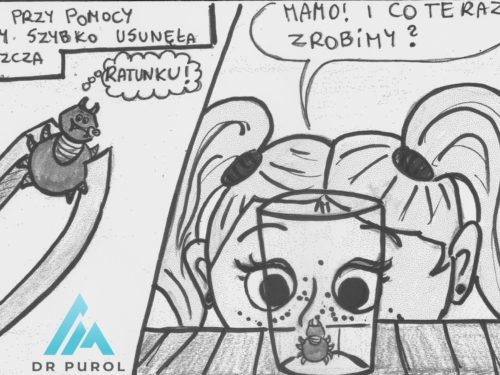
A few words about Lyme disease, or “The great adventure of the little tick”
Does every tick have Lyme disease?
No. The incidence of the disease in ticks is variable and depends on the region where ticks live – in the forest areas of north-eastern Poland, it is estimated that about 25% of ticks are infected with Borrelia. According to WHO reports, the most cases of Lyme disease were recorded in Russia, Scandinavia, North America, Australia and Central Europe.
Where and when can ticks be found?
They start the feeding season at an air temperature of about 7-10 degrees Celsius – in Poland in mid-March to the end of November. They live mainly in bushes, in a meadow, in forest areas, they can also be found in parks. They prowl attached to plants and wait for an individual to catch on their legs – this way they will climb onto their prey. Ticks do not jump from trees.
How does a person get infected?
After biting the skin, the tick anesthetizes the puncture site so that the host doesn’t feel its presence. It begins to form a tiny pit in the skin from which it drinks blood. When enlarging this cavity, it excretes various substances inside – this is when it can give a person the Borrelia spirochete (if the bacterium is in his body). Hence, it is important to have the shortest possible exposure time to ticks – the shorter it is attached to the body, the lower the risk that it will share its infected secretion.
What should we do when we find a tick in our child?
It should be removed as soon as possible using tweezers or a special set for removing ticks, e.g. a lasso. Do not cover or lubricate the stuck tick with any substances – this causes the tick to choke, it vomits into the skin cavity in defense – that is, if we come into contact with the host tick – we increase the risk of Lyme infection. After removing the insect, the wound should be disinfected.
Does the size of the tick matter?
It doesn’t matter if a tick nymph or an adult bite – any form can have Lyme disease – the risk is similar.
Is it worth testing a tick?
There is no need to do that. If we do a tick test and it turns out positive – it does not mean that our child has Lyme disease! It is more important to closely monitor the baby for early symptoms and if in doubt – perform blood serology.
So what are the first symptoms of Lyme disease?
The early acute phase of Lyme disease can have several manifestations. Erythema migrans is the most characteristic – a round or oval spot with a brightening in the middle. It shows up where we found the tick, but location varies. This may occur 3 – 30 days after exposure (up to a maximum of 3 months). Sometimes there are general symptoms, such as fever, low-grade fever, and muscle and joint pain. Lyme lymphoma is a rare form of cutaneous manifestation of Lyme disease. It has the shape of a red-blue, painless lump, it appears on the earlobe, nipple or scrotum.
Is this disease dangerous?
Untreated Lyme disease can lead to serious chronic complications. Borrelia attacks various organs: the skin, joints, heart, central or peripheral nervous system, hence the multitude of symptoms and sometimes difficulties in diagnosis.
How is Lyme disease treated?
In the treatment, we use antibacterial drugs– antibiotics. The duration of therapy, the type of antibiotic is determined by the doctor depending on the clinical form of the disease and the patient’s tolerance of the drug.
Is Lyme disease treatable?
Yes. The prognosis is good in the early stages of the disease with correct treatment.














